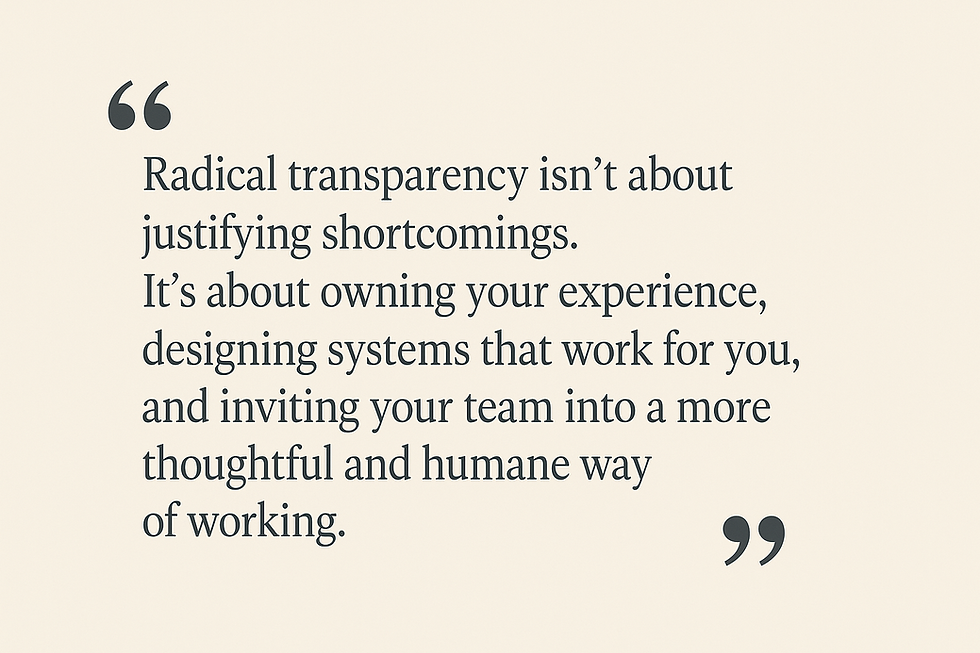Radical Transparency: What I Tell My Team About My ADHD—and Why
- Timothy Gallant
- Aug 5
- 3 min read

When I first became a leader, I was a mess behind the scenes.
My desk was covered in sticky notes, my to-do list lived half in my head and half in scattered notebooks, and deadlines felt like suggestions I was always racing to meet. I was doing my best, but the cracks were showing. I chalked it up to growing pains—new responsibilities, bigger expectations—but deep down, I feared I just wasn’t cut out for leadership.
Then I met one of the most organized, productive people I had ever worked with: a senior leader and mentor who seemed to have it all together. One day, after watching me spiral through a chaotic week, he sat me down and shared a few simple productivity systems—color-coded calendars, weekly priority resets, and breaking large tasks into micro-steps. Nothing revolutionary, but practical and tailored.
Then he said something I didn’t expect: “I have ADHD. That’s why I had to figure all of this out.”
That moment changed everything for me.
Suddenly, I didn’t feel broken. I felt seen. And more importantly, I felt like I could actually lead—not in spite of my ADHD, but by understanding it. It also planted a seed: one day, I’d share that same honesty with others.
Why I Choose to Tell My Team
For years, I hid my ADHD behind over-preparation, burnout, and anxiety. I believed transparency about my brain would make people doubt my competence. But the truth is, hiding it cost me more—relationships, clarity, and peace of mind.
Now, as a leader, I choose to be open about it. Not constantly, not dramatically—but intentionally.
I don’t share it as an excuse. I share it to build trust, set clear expectations, and model self-awareness.
What I Actually Say
I keep it simple and context-driven. Here are a few examples of what I tell my team:
When onboarding new team members: “I work best with structure—ADHD brain here—so you’ll see me rely on a lot of systems and reminders. If I ever miss something, just flag it for me. It’s never personal.”
When I make a mistake or miss something: “That one slipped through the cracks. Totally on me—I’m adjusting my system to make sure it doesn’t happen again.”
When explaining how I work best: “I process things better visually, so I may sketch out ideas or use task boards—it helps me stay clear and focused.”
The goal isn’t to overshare. It’s to set up honest working relationships rooted in mutual understanding.
The Impact: Safety, Clarity, and Better Leadership
Since becoming more open about my ADHD, I’ve noticed something powerful happen in every team I’ve led:
People breathe easier. They see that it’s okay not to be perfect. That you can lead with both structure and humanity.
It builds real trust. I’m not hiding. I’m not making excuses. I’m inviting my team into how I work—and what I’m doing to grow.
It improves communication. If I need a nudge, they know it’s safe to give it. If they need support, they know it’s okay to ask.
And best of all, it creates a culture where people feel safe being real with me, too.
Transparency Is Not Oversharing
Radical transparency isn’t about dumping your personal challenges on your team. It’s about intentional context. I don’t lead with my diagnosis, and I don’t ask for special treatment. I lead with ownership, clarity, and respect for how different brains work—including mine.
If You're a Leader with ADHD…
You don’t have to hide who you are to be effective. You just need to lead with intention.
Radical transparency is about creating space—for yourself and for others—to work in ways that are honest, humane, and sustainable. When you lead from that place, ADHD isn’t your liability—it’s your insight.
Leadership isn’t about looking flawless. It’s about being real, building trust, and showing your team that growth is a shared journey.
And if one of them one day says, “Knowing that about you helped me feel seen,” you’ll know you did something right.




Comments